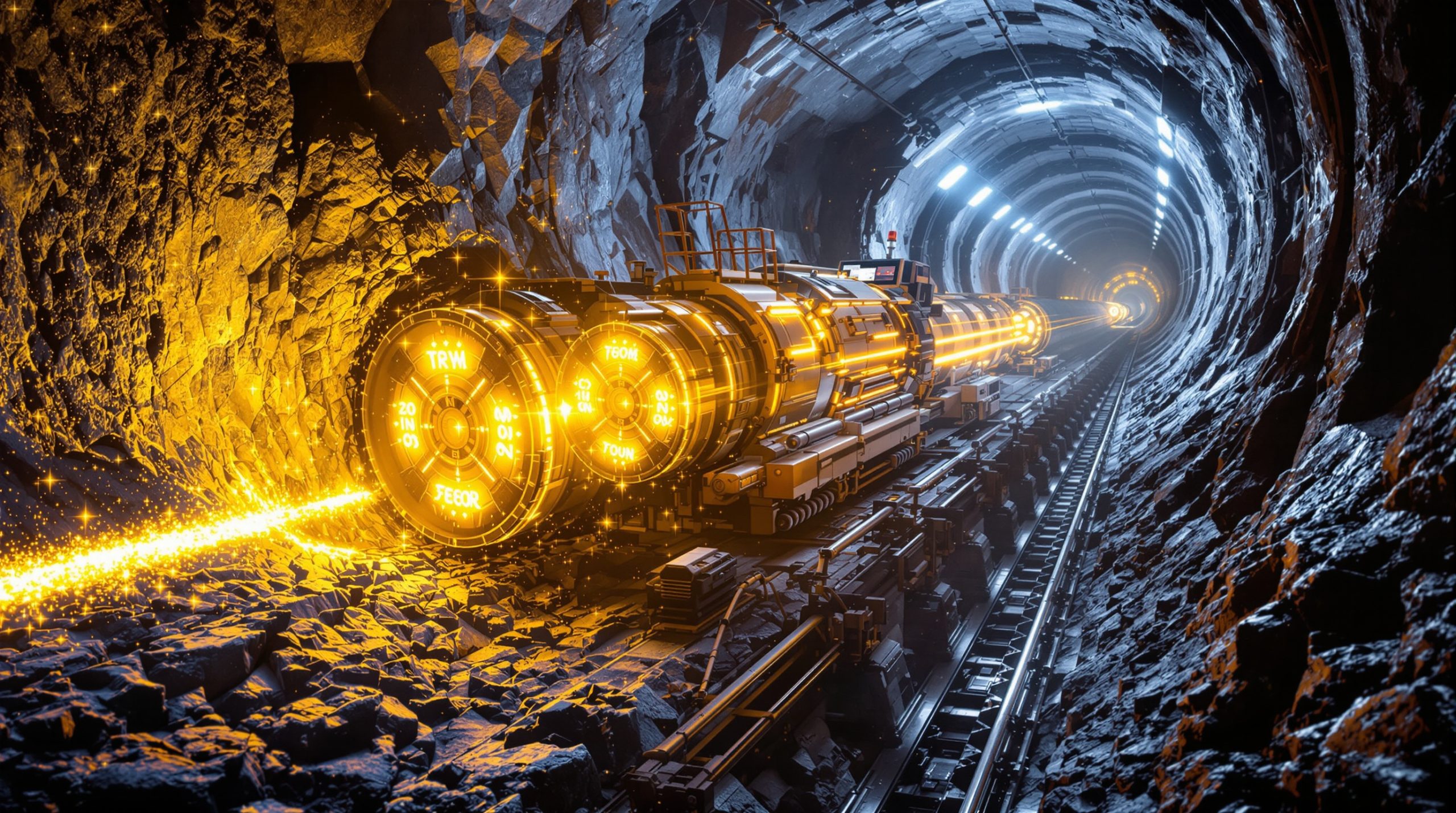How is Technology Driving the Nuclear Renaissance?
The technology sector's investment in uranium is experiencing an unprecedented energy challenge as artificial intelligence infrastructure demands massive, reliable power sources. Major tech companies are strategically investing in nuclear energy, creating a fundamental shift in uranium demand patterns that extends beyond traditional utility procurement cycles.
Tech Giants Lead Nuclear Power Revival
Microsoft's landmark decision to join the World Nuclear Association signals a paradigm shift in how technology companies approach energy security. This institutional commitment represents more than symbolic support—it demonstrates strategic recognition of nuclear power's essential role in maintaining competitive advantage in artificial intelligence development.
Amazon has committed $500 million to small modular reactor (SMR) development while establishing comprehensive nuclear supply agreements. Meta has similarly positioned itself in the nuclear space, recognizing the competitive necessity of securing reliable, carbon-free electricity sources.
AI Infrastructure Creates Sustained Uranium Demand
The energy requirements for artificial intelligence data centers are transforming electricity consumption patterns globally. A single small modular reactor can power either 700,000 homes or a major data center complex, illustrating the energy density required for computational infrastructure.
Unlike previous uranium market volatility driven primarily by utility procurement or financial speculation, technology companies are making long-term infrastructure investments that create sustained consumption patterns. This fundamental shift provides greater visibility and durability in uranium demand forecasts.
Why Are Uranium Supply Constraints Intensifying?
While demand accelerates from new technology sector requirements, the uranium supply response has consistently disappointed across established producers, creating a widening supply-demand imbalance.
Operational Challenges Plague Established Producers
Major uranium producers face persistent operational difficulties that limit production capacity. Kazakhstan's Kazatomprom has struggled to meet production guidance for multiple consecutive years, while Cameco recently announced shortfalls in projected output.
The challenges of restarting idle uranium operations resemble bringing long-stored vehicles back to operational status—seemingly straightforward but fraught with unexpected complications. Even when production resumes, efficiency rarely matches nameplate capacity, creating persistent output gaps.
Technical Complexities Span Global Operations
In-situ recovery operations face particular technical challenges across multiple jurisdictions:
- Kazakhstan struggles with sulfuric acid cost inflation
- Paladin's Namibia halt comes amid algae issues in operations
- Production shortfalls appear systemic rather than isolated
These difficulties span globally, suggesting fundamental rather than localized operational challenges in uranium production.
Extended Development Timelines Prevent Quick Supply Response
The uranium supply picture becomes more concerning when considering the limited pipeline of new projects. Industry experts note that uranium project development typically requires:
| Development Stage | Typical Timeline |
|---|---|
| Exploration to Production Decision | 10+ years |
| Full Project Lifecycle | 15-20 years |
| Regulatory Approval Process | 5-7 years |
This extended development horizon means current supply constraints will persist even with immediate investment in new projects, creating a structural advantage for companies with advanced assets.
What Strategic Vulnerabilities Does America's Uranium Deficit Create?
The United States faces a particularly acute uranium supply challenge that creates both strategic vulnerabilities and investment opportunities in domestic production.
Critical Domestic Production Shortfall
American nuclear infrastructure faces a substantial supply gap:
| U.S. Uranium Market Dynamics | Annual Volume (Million Pounds) |
|---|---|
| Utility Consumption | 50 |
| Domestic Production Capacity | 4-5 |
| Annual Deficit | 45-46 |
This 90% supply deficit occurs during heightened geopolitical tensions, raising energy security concerns at the highest levels of government.
Policy Response Creates Investment Catalyst
The current administration has implemented multiple policy initiatives supporting domestic uranium development:
- Designation of uranium as a critical mineral
- Implementation of Defense Production Act provisions
- Development Finance Corporation funding for uranium projects
- Strategic reserve programs creating additional demand
These US production and security initiatives provide both regulatory support and potential funding sources for companies developing uranium assets in the United States.
How Are Technology Companies Transforming Nuclear Investment?
The technology sector's investment in uranium differs fundamentally from traditional utility procurement models, creating new financing structures and development pathways.
Capital Scale Advantage
Technology companies possess market capitalizations exceeding entire stock exchanges, enabling unprecedented capital deployment into nuclear infrastructure. This financial capacity allows comprehensive vertical integration strategies spanning uranium mining through power generation.
Long-Term Infrastructure Perspective
Unlike utilities focused on quarterly performance metrics, technology companies approach nuclear energy as strategic infrastructure with multi-decade investment horizons. This perspective aligns with uranium's extended development timelines and provides greater stability for project financing.
Sophisticated Financing Structures
The uranium sector has developed innovative financing approaches that address traditional mining investment concerns:
- Convertible bond structures reducing interest costs by over $100 million compared to conventional project finance
- Strategic partnerships providing development capital without equity dilution
- Royalty and streaming arrangements creating alternative funding pathways
These structures enhance project economics while reducing shareholder dilution risk traditionally associated with mining development.
Which Jurisdictions Offer Superior Uranium Investment Opportunities?
Successful uranium investment strategies require careful attention to jurisdictional advantages and geological potential, with established uranium regions offering superior risk-adjusted returns.
Athabasca Basin: Unmatched Geological Potential
Canada's Athabasca Basin remains the premier uranium exploration and development jurisdiction globally, offering:
- Highest-grade uranium deposits worldwide
- Established regulatory framework with decades of operational history
- Substantial infrastructure supporting efficient development
- Proximity to processing facilities reducing capital requirements
Companies operating in the Athabasca Basin benefit from geological continuity and extensive technical databases that reduce exploration risk.
Wyoming: America's Uranium Heartland
Wyoming represents America's most established uranium jurisdiction with:
- Historical production exceeding any other U.S. state
- Well-defined regulatory pathway for in-situ recovery operations
- Supportive state government policies
- Existing infrastructure reducing development costs
Wyoming's geological continuity provides technical advantages for companies developing projects in established uranium districts.
Jurisdictional Risk Considerations
The geopolitical landscape creates additional investment considerations beyond geology:
- Kazakhstan's production dominance creates concentration risk
- Russia's uranium conversion and enrichment capacity influences global supply chains
- Australia's regulatory complexity despite substantial resource potential
- Africa's variable political stability affecting development timelines
These jurisdictional factors influence both project development risk and strategic value in supply security contexts.
What Market Indicators Signal Uranium Price Discovery?
The uranium market demonstrates multiple indicators suggesting significant price appreciation potential from current levels.
Institutional Price Targets
Financial institutions have established uranium price forecasts substantially above current spot levels:
| Institution | Price Target | Timeframe |
|---|---|---|
| Citibank | $100+ | End of 2025 |
| Bank of America | $85-95 | 2026 |
| Morgan Stanley | $80-90 | 2025-2026 |
These price targets reflect fundamental supply-demand imbalances rather than speculative positioning.
Production Cost Economics
Current uranium pricing remains below the marginal cost of production for many operations:
- Existing producers operating below nameplate capacity face higher per-unit costs
- New project development requires sustained prices above $65-70 per pound
- Inflation in key inputs including sulfuric acid, labor, and energy increases production costs
This cost structure creates a natural price floor while supporting upside potential as demand increases.
Contract Market Dynamics
The uranium market operates with distinct spot and long-term contract segments:
- Utilities typically secure 70-80% of requirements through long-term contracts
- Current contract coverage approaching historical lows of 55-60%
- Limited contract volumes during 2016-2020 price depression creates renewal cliff
- Technology company demand adds competition for available contract volumes
These contract dynamics create additional demand pressure beyond spot market activity.
How Does the AI Revolution Change Uranium Investment Thesis?
The artificial intelligence revolution fundamentally transforms the uranium investment thesis by creating sustained demand growth beyond traditional utility requirements.
Data Center Power Requirements
AI infrastructure creates unprecedented electricity demand:
| AI Application | Power Requirement |
|---|---|
| Large Language Model Training | 3,000-5,000 MWh |
| Data Center Complex | 1-2 GW continuous |
| Single ChatGPT Query | 10-15 Wh |
These power requirements multiply across thousands of applications and billions of users, creating exponential electricity demand growth.
Nuclear's Unique Advantages for AI Infrastructure
Nuclear energy offers specific advantages for AI applications:
- Consistent baseload generation matching computational requirements
- Carbon-free operation supporting environmental commitments
- Energy density reducing land use compared to renewable alternatives
- Reliability exceeding 90% capacity factor versus 25-40% for intermittent sources
These characteristics align precisely with AI infrastructure requirements, creating natural partnership opportunities.
Strategic Competitive Positioning
Technology companies recognize nuclear energy access as a competitive differentiator in the AI landscape. As F3 Uranium CEO Dev Randhawa notes, "Whoever wins the race to have more scalable green energy has a better chance of winning the AI wars."
This strategic imperative drives tech giants turning to uranium beyond simple electricity procurement to comprehensive nuclear infrastructure development.
What Consolidation Opportunities Exist in the Uranium Sector?
The uranium sector demonstrates multiple indicators suggesting industry consolidation will accelerate as market conditions improve.
Resource Replacement Requirements
Established producers face resource depletion requiring replacement:
- Major producers operating mines approaching end-of-life status
- Limited exploration success during extended price depression
- Acquisition costs below replacement value for many junior developers
- Technical expertise concentration creating operational synergies
These factors create natural consolidation incentives as production companies seek resource replacement.
Financing Advantage Gap
The financing capability gap between established producers and developers creates acquisition opportunities:
- Established producers generate substantial cash flow at current uranium prices
- Junior developers face challenging equity markets despite improving fundamentals
- Debt financing remains limited for pre-production companies
- Strategic partnerships offer alternative development pathways
This financing differential creates natural consolidation opportunities as market conditions improve.
Strategic Buyer Emergence
The uranium sector has attracted strategic investors beyond traditional mining companies:
- Sovereign wealth funds seeking supply security
- Technology companies pursuing vertical integration
- Private equity recognizing fundamental value disconnect
- Specialized uranium investment vehicles with acquisition mandates
These non-traditional buyers create additional consolidation pathways beyond producer-led acquisitions.
What Investment Approach Maximizes Uranium Exposure?
The uranium investment thesis requires careful portfolio construction to maximize exposure while managing development and market risks.
Strategic Exposure Through Advanced Developers
Companies with proven management teams, advanced projects in established jurisdictions, and strong balance sheets offer superior risk-adjusted returns. These organizations can execute development plans without dilutive financing pressure while maintaining upside exposure to improving market conditions.
Geographic Diversification Across Allied Nations
Prioritizing exposure to uranium projects in stable, allied jurisdictions including Canada's Athabasca Basin, Wyoming's established uranium districts, and Australia's uranium provinces mitigates geopolitical risks while maintaining production potential.
Portfolio Approach for Risk Management
A portfolio approach across multiple development stages and assets reduces execution risk while maintaining upside potential across various market scenarios. This diversification strategy addresses the inherent operational challenges demonstrated across the uranium production landscape.
Technology Sector Demand Recognition
Investing based on structural demand shifts from AI and data center growth rather than traditional utility-driven cycles recognizes the fundamental transformation in uranium consumption patterns. This perspective creates longer investment horizons aligned with infrastructure development timelines.
Supply Constraint Beneficiaries
Companies positioned to benefit from industry-wide production challenges and extended development timelines that create barriers to new supply additions offer particular advantage. These organizations can capitalize on pricing power created by persistent supply deficits.
Government Policy Alignment
Projects that align with national security objectives and benefit from government support programs including strategic reserves, Development Finance Corporation backing, and critical mineral designations receive both regulatory and potential financing advantages.
Balance Sheet Strength Priority
Companies with adequate funding to complete development plans without additional equity dilution during potentially volatile market conditions maintain greater value capture potential. This financial flexibility allows optimization of development timing rather than forced execution based on capital constraints.
Timing Optimization
Strategic entry positions before regulatory approvals and production decisions create exposure to step-change revaluations from developer to producer status. These catalytic events typically trigger substantial valuation improvements independent of uranium price movements.
FAQ: Technology Sector's Investment in Uranium
Why are technology companies suddenly interested in nuclear energy?
Technology companies face unprecedented electricity demands from artificial intelligence infrastructure that require reliable, carbon-free baseload power. Nuclear energy provides the consistent, high-density power generation essential for data center operations while supporting corporate environmental commitments.
How does AI development influence uranium demand?
Artificial intelligence development requires massive computational resources powered by consistent electricity supply. A single large language model training session can consume thousands of megawatt-hours, while ongoing inference operations require continuous power. This creates sustained electricity demand that nuclear energy efficiently addresses.
What advantages does nuclear power offer over renewable alternatives for tech companies?
Nuclear power provides consistent baseload generation with over 90% capacity factor compared to 25-40% for intermittent renewable sources. This reliability eliminates the need for backup generation or storage systems while delivering carbon-free electricity that supports environmental commitments.
How are technology companies participating in the nuclear supply chain?
Technology companies employ multiple strategies including direct investment in small modular reactor development, nuclear supply agreements with utilities, World Nuclear Association membership, and potential vertical integration into uranium investment in Canada and other mining jurisdictions.
What timeframe do technology investments in nuclear energy require?
Technology companies approach nuclear energy with 20-30 year investment horizons aligned with infrastructure development timelines. This long-term perspective matches the extended development and operational lifecycle of nuclear assets while supporting strategic energy security objectives.
Key Takeaways: Technology Sector's Strategic Uranium Investment
The uranium investment thesis combines structural demand growth, persistent supply constraints, and strategic value recognition creating compelling risk-adjusted return potential:
-
Technology sector demand transformation: Major technology companies including Microsoft, Amazon, and Meta commit unprecedented capital to nuclear energy infrastructure, creating sustained demand beyond traditional utility cycles.
-
Persistent supply challenges: Established producers consistently struggle with operational difficulties while new project development timelines span decades, constraining supply responses to growing demand.
-
Strategic value recognition: Government policy support through critical mineral designations, Development Finance Corporation backing, and strategic reserve programs validates uranium's essential role in energy security.
-
Sophisticated financing evolution: Innovative funding structures including convertible bonds, strategic partnerships, and royalty arrangements address traditional mining investment concerns while enhancing project economics.
-
Jurisdictional advantage differentiation: Companies operating in established uranium jurisdictions with proven geology and regulatory clarity demonstrate superior development potential compared to frontier regions.
-
AI-driven demand sustainability: Artificial intelligence infrastructure creates fundamental electricity demand growth that nuclear energy efficiently addresses, establishing long-term consumption patterns beyond cyclical utility procurement.
-
Consolidation catalyst potential: Resource replacement requirements, financing capability gaps, and strategic buyer emergence create multiple pathways for industry consolidation as market conditions improve.
The technology sector's investment in uranium represents a fundamental transformation in uranium demand patterns that extends beyond traditional utility procurement cycles. This structural shift, combined with persistent supply constraints and government policy support, creates compelling investment opportunities in nuclear energy for companies with advanced projects in established jurisdictions, proven management teams, and strong financial positions.
Want to Stay Ahead of the Next Major Mineral Discovery?
Discovery Alert's proprietary Discovery IQ model instantly notifies investors of significant ASX mineral discoveries, turning complex data into actionable insights that could lead to substantial returns. Explore how historic discoveries have generated exceptional outcomes by visiting Discovery Alert's dedicated discoveries page.




